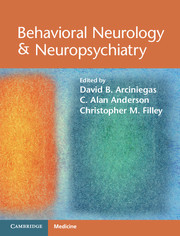Crossref Citations
This Book has been
cited by the following publications. This list is generated based on data provided by Crossref.
Lamb, Richard L.
Vallett, David B.
Akmal, Tariq
and
Baldwin, Kathryn
2014.
A computational modeling of student cognitive processes in science education.
Computers & Education,
Vol. 79,
Issue. ,
p.
116.
Rodríguez‐Porcel, Federico
and
Espay, Alberto J
2014.
Encyclopedia of Life Sciences.
Benjamin, Sheldon
Widge, Alik
and
Shaw, Kailie
2014.
Neuropsychiatry and Neuroscience Milestones for General Psychiatry Trainees.
Academic Psychiatry,
Vol. 38,
Issue. 3,
p.
275.
Tkach, Bohdan
2016.
THE FEATURES OF THE TEAM-MODEL OF NEUROPSYCHOLOGICAL REHABILITATION FOR AFFECTED ANTI-TERRORIST OPERATION PARTICIPANTS.
Proceedings of the Shevchenko Scientific Society Medical sciences,
Vol. 47,
Issue. 2,
p.
10.
Nithiya
E., Sabarinathan
and
E., Manoj
2017.
An Innovative Method for Brain State Classification from EEG Data using Hybrid Learning Algorithm.
i-manager’s Journal on Pattern Recognition,
Vol. 3,
Issue. 4,
p.
8.
McDonald, Brenna C
Flashman, Laura A
Arciniegas, David B
Ferguson, Robert J
Xing, Li
Harezlak, Jaroslaw
Sprehn, Gwen C
Hammond, Flora M
Maerlender, Arthur C
Kruck, Carrie L
Gillock, Karen L
Frey, Kim
Wall, Rachel N
Saykin, Andrew J
and
McAllister, Thomas W
2017.
Methylphenidate and Memory and Attention Adaptation Training for Persistent Cognitive Symptoms after Traumatic Brain Injury: A Randomized, Placebo-Controlled Trial.
Neuropsychopharmacology,
Vol. 42,
Issue. 9,
p.
1766.
Machado, Leonardo
de Oliveira, Irismar Reis
Peregrino, Antonio
Cantilino, Amaury
and
Tesfaye, Markos
2019.
Common mental disorders and subjective well-being: Emotional training among medical students based on positive psychology.
PLOS ONE,
Vol. 14,
Issue. 2,
p.
e0211926.
Jahan, Ali
Nazari, Mohammad Ali
Mahmoudi, Javad
Salehpour, Farzad
and
Salimi, Maryam Moghadam
2019.
Transcranial near-infrared photobiomodulation could modulate brain electrophysiological features and attentional performance in healthy young adults.
Lasers in Medical Science,
Vol. 34,
Issue. 6,
p.
1193.
Beresford, Thomas
Ronan, Patrick J
and
Hipp, Daniel
2021.
A 5-Minute Cognitive Assessment for Safe Remote Use in Patients With COVID-19: Clinical Case Series.
JMIR Formative Research,
Vol. 5,
Issue. 6,
p.
e26417.
Lamb, Richard
Hand, Brian
and
Kavner, Amanda
2021.
Computational Modeling of the Effects of the Science Writing Heuristic on Student Critical Thinking in Science Using Machine Learning.
Journal of Science Education and Technology,
Vol. 30,
Issue. 2,
p.
283.
Simonetti, Alessio
Saxena, Kirti
Koukopoulos, Alexia E.
Janiri, Delfina
Lijffijt, Marijn
Swann, Alan C.
Kotzalidis, Georgios D.
and
Sani, Gabriele
2022.
Amygdala structure and function in paediatric bipolar disorder and high-risk youth: A systematic review of magnetic resonance imaging findings.
The World Journal of Biological Psychiatry,
Vol. 23,
Issue. 2,
p.
103.
Ramadass, Karthik
Rheault, Francois
Cai, Leon Y.
Remedios, Lucas W.
D'Archangel, Micah
Lyu, Ilwoo
Barquero, Laura A.
Newton, Allen T.
Cutting, Laurie E.
Huo, Yuankai
Landman, Bennett A.
Išgum, Ivana
and
Colliot, Olivier
2022.
Ultra-high-resolution mapping of cortical layers 3T-guided 7T MRI.
p.
49.
Ojell, Heta
Palohuhta, Maria
and
Ferreira, Juliene Madureira
2023.
A Qualitative Microanalysis of the Immediate Behavioural Effects of Mindfulness Practices on Students’ Self-Regulation and Attention.
Trends in Psychology,
Vol. 31,
Issue. 4,
p.
641.
Simonetti, Alessio
Lijffijt, Marijn
Kurian, Sherin
Saxena, Johanna
Janiri, Delfina
Mazza, Marianna
Carriero, Giulio
Moccia, Lorenzo
Mwangi, Benson
Swann, Alan C.
and
Soares, Jair C.
2023.
Neuroanatomical Correlates of the Late Positive Potential in Youth with
Pediatric Bipolar Disorder.
Current Neuropharmacology,
Vol. 21,
Issue. 7,
p.
1617.





